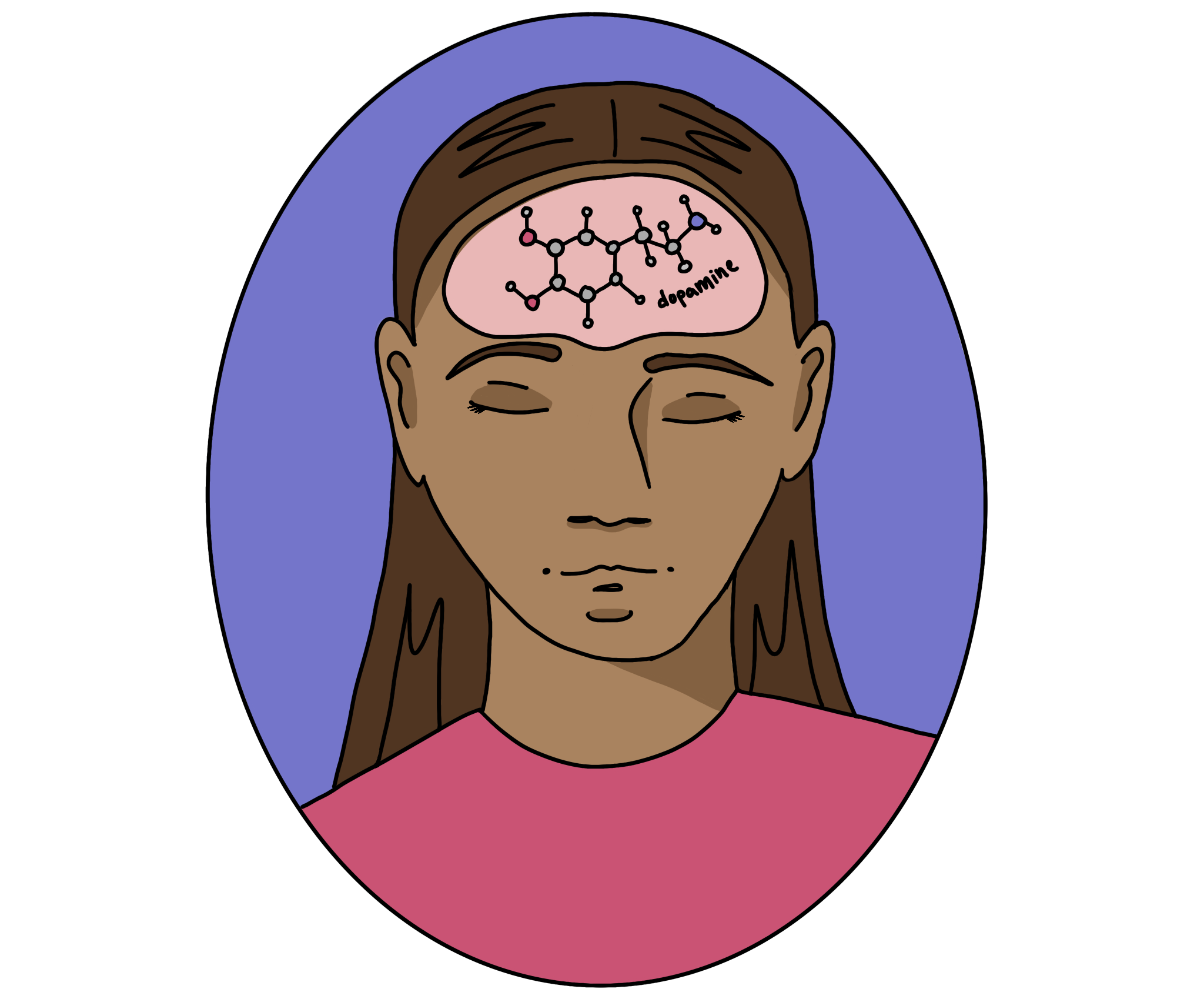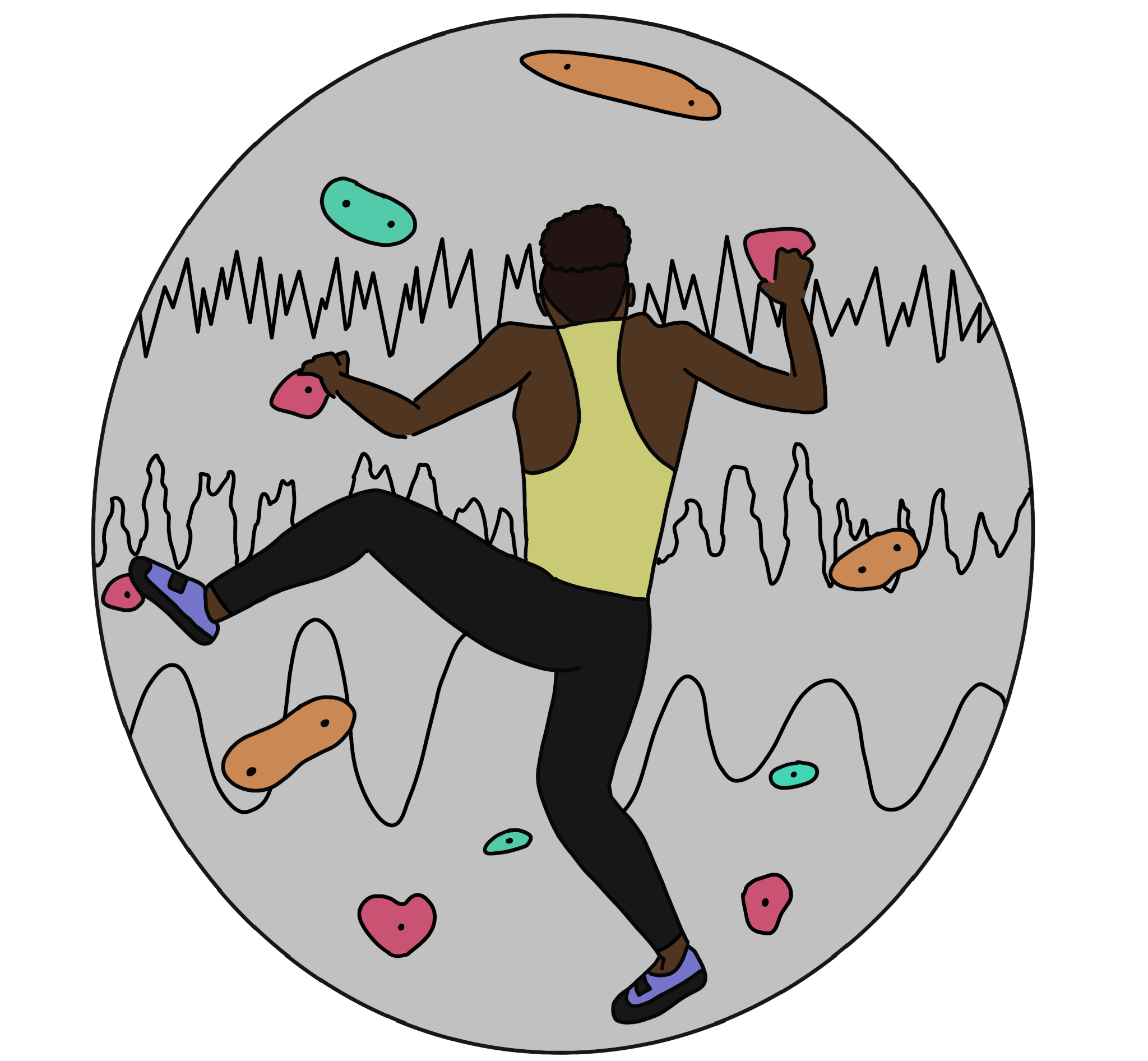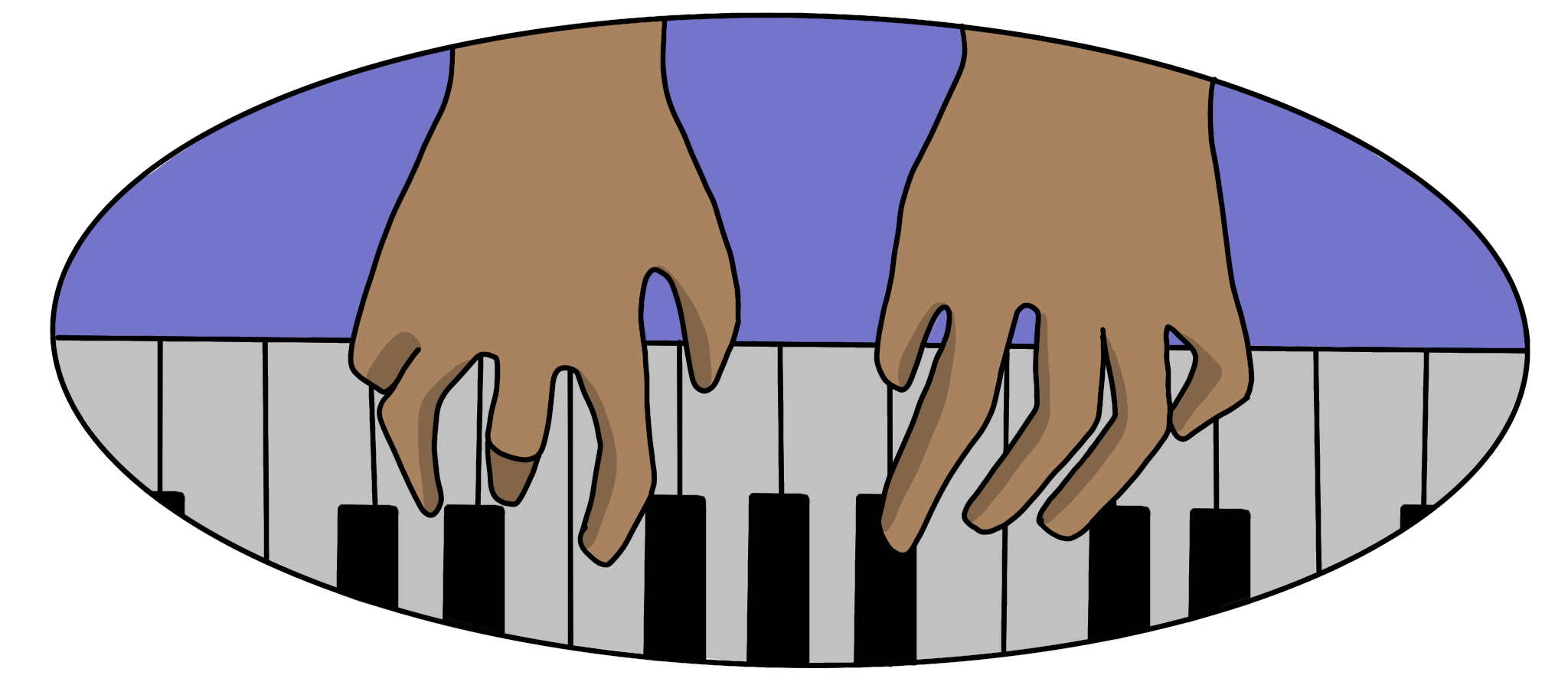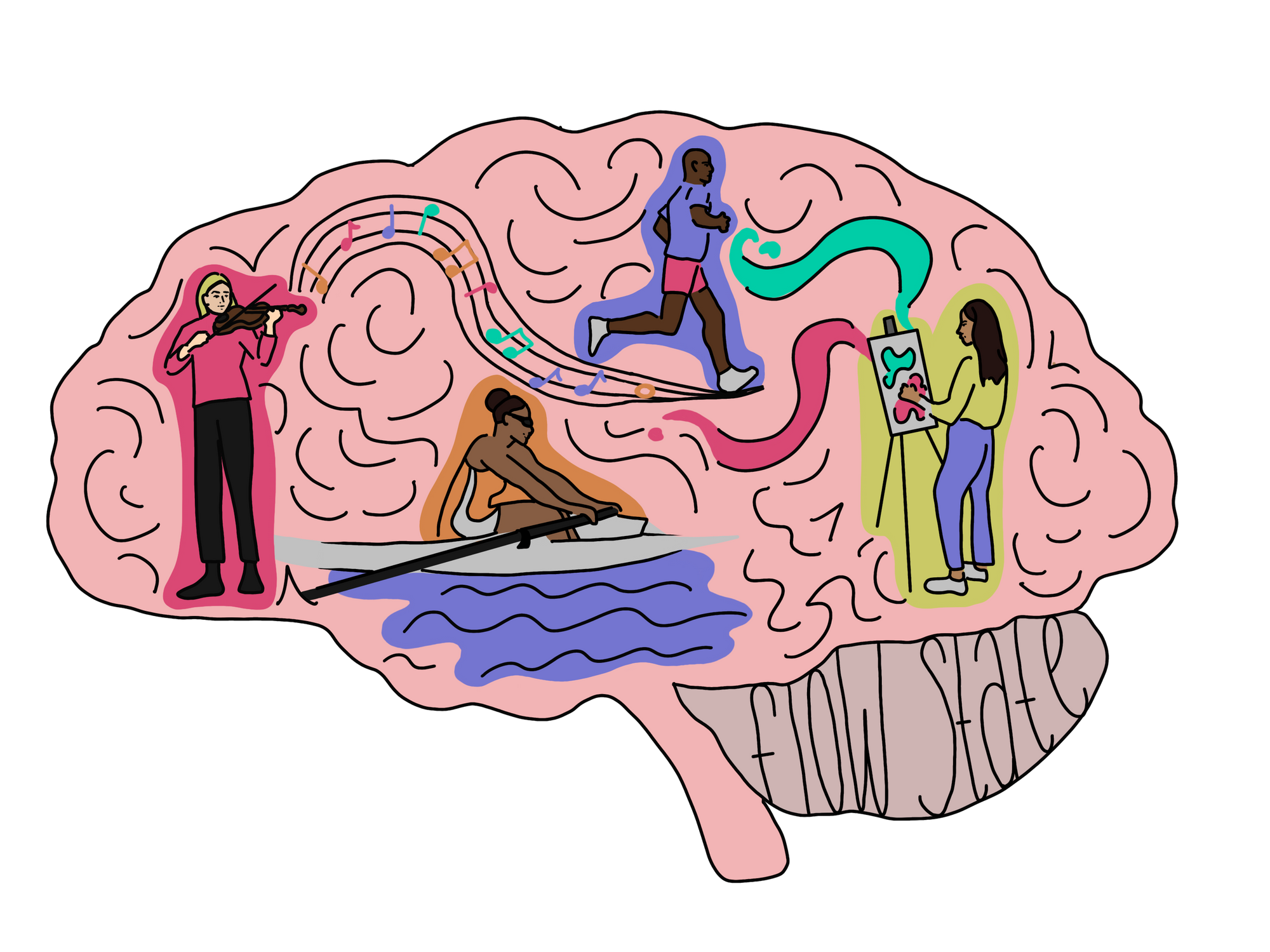Imagine a moment when your mind and body are fully immersed in a task and every fiber of your being is dedicated to completing it — when time stops and all distractions fade away. This is the essence of flow state.
Flow, often dubbed as being “in the zone,” is a mental state where an individual is completely absorbed in a task and exhibits a strong sense of drive [1]. This state of mind is commonly seen among athletes, artists, and scientists, but anyone can experience flow in any task. Often, flow state is reached when an individual’s skill set matches the skills required for the task at hand, and the work is neither overwhelming nor underwhelming. Multiple signs are displayed when an individual reaches flow state, including immense focus, lack of self-consciousness, enjoyment, and persistence. During flow, individuals experience a deep sense of satisfaction and fulfillment, which can lead to heightened creativity, productivity, and overall well-being [1].
Dimensions of Flow
The idea of flow state was first introduced by Mihaly Csikszentmihalyi in 1975, who characterized the experience by nine key dimensions [2].
First, individuals experience a challenge-skill balance, or a balance between their skills and the challenges of a situation [1]. If the challenges outweigh an individual’s ability, they face frustration rather than flow. If the opposite is true, boredom develops.
Soon, an individual’s behavior becomes automatic and spontaneous and there is little awareness of self, leading to a merging of action and awareness.
As one gets deeper into flow, they experience a strong sense of action and clarity of goals.
As the individual progresses through flow, the activity provides clear, immediate, and unambiguous feedback regarding progress towards their goals.
Flow peaks as individuals disregard distractions and experience extreme focus and concentration on the task at hand.
Individuals also experience an automatic sense of exercising control, known as the paradox of control. Those who have experienced flow report a strong sense of control, but a loss of flow as soon as they consciously try to maintain that control.
A loss of self-consciousness develops as all concern for self disappears when an individual is immersed in the task at hand.
Throughout flow, individuals experience a seeming transformation of time, where they have a distorted sense or completely lose track of time.
Overall, flow is characterized as an autotelic experience, or intrinsically motivating an individual to return to this state.
These nine dimensions encapsulate the optimal experience of flow. Flow can occur when any number of these dimensions are met; however, more criteria correlate to a more intense flow experience [1].
Unraveling the Neurobiology of Flow
There are multiple neural systems and networks involved in flow state. Although their exact functions and relationships are yet to be mapped out, scientists have a general idea of each network’s role and extent of involvement in flow.

One crucial neural network in flow is the dopaminergic reward pathway [1]. Flow is often experienced during activities that are highly and intrinsically rewarding to an individual. There are several brain regions associated with mediating the rewarding aspects of tasks. A core component associated with the dopaminergic reward pathway is the nucleus accumbens, which receives dopamine-related input from the midbrain and plays a crucial role in feelings of reward, satisfaction, pleasure, and motivation. Activation of dopaminergic pathways in the nucleus accumbens plays a role in experiencing enjoyment, hope, and optimism, all of which are feelings associated with flow. Additionally, dopaminergic reward systems are thought to be involved in the decision-making associated with beginning, continuing, and completing tasks that involve flow [1].
The locus coeruleus-norepinephrine (LC-NE) system is also involved in flow state [3]. The LC is a small, nucleus-like structure in the brain and is a primary site of NE release [3]. NE is a neurotransmitter primarily involved with the brain’s “fight-or-flight response,” but has broad functions, including connections with decision-making [4]. The LC-NE system plays a significant role in sleep and wakefulness, as well as regulating the brain’s arousal levels [1]. Now, it has been found that the system is involved in functions such as motivation and attention, along with task engagement, which are significant qualities of flow [5]. A study by Jennifer Ross and Elisabeth Bockstaele has shown that the LC-NE system is pivotal in the brain’s balance between engagement and disengagement, based on the rewards and costs of an activity [5]. The overlap between the qualities of flow and characteristics of the LC-NE system suggests a connection between the two, but there are currently no published studies that explicitly research this relationship.
Apart from the dopaminergic reward system and the LC-NE system, there are other larger-scale networks involved in regulating flow state. These include the Default Mode Network, the Central Executive Network, and the Salience Network.
The Default Mode Network (DMN) consists of various brain regions that activate when individuals are not engaged in active cognitive tasks, but rather during mind-wandering: anticipating and planning past, present, and future situations [1]. A reduction in DMN activity relates to a decrease in thinking or worrying about oneself, which is a prominent characteristic of flow, implicating the DMN in a loss of self-consciousness. The lowered activation of the DMN during flow is measured through reduced negative stress, which decreases an individual’s feelings of losing control, and high task focus, all of which are characteristics of flow state.
The Central Executive Network (CEN) consists of multiple interconnected brain regions that activate when engaging in external cognitive processing, during tasks that require high focus and concentration. Hence, the CEN and DMN often activate contrastingly; when the CEN increases activation, the DMN decreases, and vice versa. CEN activation primarily entails explicit processing, which refers to brain processing that involves working memory, focused attention, and conscious awareness of actions. Implicit processing, on the other hand, refers to more automatic processing where one unconsciously applies previously learned knowledge or skills. Flow involves both types of processing, as the task at hand is significant enough to require a combination of unconscious, well-learned behavior and strong attentional focus, suggesting that the CEN may be involved in flow state.
The Salience Network (SN) is a third neural network likely involved in flow. Its two main regions are consistently active during most cognitive tasks and serve broad functions. The SN acts as a median between the DMN and the CEN, continuously switching between task concentration and mind-wandering. The SN derives its name from its ability to detect the salience, or significance, of stimuli based on the input of the previously mentioned dopaminergic reward and LC-NE systems. SN is important to exhibiting a sense of control, signaling that tasks are going according to plan and an individual is successfully working towards achieving their goals, suggesting a relation with flow state. If the challenge-skill balance is disturbed due to an activity becoming more difficult, the SN registers performance errors, indicating this disruption and consequently activating or deactivating the CEN or DMN as needed.
Although discrete, each system or network works together to create a cohesive state of flow. Flow begins when an individual engages in a task that is intrinsically motivating, meaningful, or enjoyable. Dopaminergic reward and the LC-NE systems both enhance engagement in the task, freeing the individual from external distractions and reinforcing the drive to be in a state of flow. Furthermore, the DMN, CEN, and SN may play a role in flow state, suggested by the similarity between their functions and the characteristics of flow state. Each of these networks have overlapping functions with each other and with the qualities of flow, prompting a need for further research into their interconnectivity [1].

Researching and Measuring Flow
An early method to measure flow is the experience-sampling method (ESM), developed by Csikszentmihalyi in 1987 [6]. During ESM, participants are equipped with electronic devices that prompt them at random intervals throughout the day to report information about their current mood, activities, and experiences on the Experience-Sampling Form, through both quantitative and qualitative questions. Over time, ESM utilizes these real-time data points to create a more representative assessment of flow experiences, allowing researchers to determine patterns, triggers and environmental factors that contribute to flow state [6]. The primary drawback of ESM is its time-consuming, demanding, and interruptive nature, but it is still commonly used to measure flow to grasp the subjective and qualitative characteristics of the experience [7].
Another common way to measure flow is using the Flow State Scale, developed by researchers Susan A. Jackson and Herbert W. Marsh in 1996 [8]. This 36-question survey asks participants to rank their agreement on different statements related to challenge-skill balance, control, self-awareness, and other flow factors, on a 5-point scale. The Flow State Scale is widely known for incorporating both qualitative and quantitative research, and was a breakthrough in the ongoing attempt to develop a psychometrically valid and usable scale to assess flow [8].
Flow can also be measured physiologically through electromyographic signals (EMGs), which generally measure the electrical currents generated during muscular contraction [9]. Although flow state is primarily a psychological construct, EMGs measure muscle activity that may be associated with focus, attention, and optimal performance. During flow-inducing activities, individuals experience the effortless, automatic muscle movement characteristic of implicit processing. Repetitive patterns of these muscle movements can be measured through EMGs and can serve as indications of flow state. Additionally, EMG muscle activation levels and patterns can be compared between flow-inducing tasks and states of boredom, anxiety, or distraction [9].
However, progress in research within this field has been impeded by the lack of standardization among defining and measuring flow due to its abstract nature [10].
Flow in Athletes and Musicians
Flow state is present across a wide range of fields and can even occur in daily life. However, it is especially prevalent among athletes and musicians. While experiencing flow, they often feel at their peak, achieving the highest level of performance in their respective fields. Furthermore, flow state is associated with pleasure in undertaking a task and a feeling of fulfillment among performers.
In sports, flow has been associated with high-quality performance and confidence [11]. In a study done by Aherne, Moran, and Lonsdale, four national-level tennis players utilized a tailored imagery script targeting challenge-skills balance, clear goals, concentration on the task at hand, and a sense of control. After 8-11 matches, three out of four athletes showed significant increases in performance, measured by the number of winners hit by serves, and forehand and backhand groundstrokes, and all four athletes increased their national rankings [11]. Another study by Koehn and colleagues found that the athlete participants that self-reported being in flow during competition increased in national rankings and significantly increased in performance compared to their baseline levels [12]. Hence, flow is suggested to improve athletic performance in general.

In music, flow is recalled during improvisation, interpretation, and composition [13]. In classically trained musicians, flow is primarily a result of self-regulated behaviors, such as an individual’s practice routine. Among music teachers, performance feedback, musical autonomy, social support, and supervisory coaching all contribute to the experience of flow [13].
Among students in academia, flow state shows a significant correlation with cognitive load, self-efficacy, test performance, and difficulty factors [14]. Improving student-oriented factors like self-efficacy and test performance seemed to increase flow experience. Additionally, lower cognitive load and difficulty factors were found to increase flow. However, this should not be interpreted as giving students “easy tests” to induce flow. Rather, tests with optimal difficulty balance learning challenges with flow and motivation to push students’ learning progression, applying the challenge-skill balance dimension of flow [14].
Conclusion
Flow state stands as a captivating phenomenon among the worlds of psychology and neuroscience. It represents a harmony between challenge and skill, where individuals find themselves immersed in the present moment, fully engaged and effortlessly absorbed in their activities. As scientists delve deeper into understanding this optimal state, they continue discovering flow’s potential to enhance performance and its profound implications for personal fulfillment and wellbeing. By cultivating environments and practices conducive to flow, we can pave the way towards a world where flow becomes an integral and constant aspect of our daily lives.
References
1. van der Linden, D., Tops, M., & Bakker, A. B. (2020). Go with the flow: A neuroscientific view on being fully engaged. European Journal of Neuroscience, 53: 947–963. https://doi.org/10.1111/ejn.15014
2. Katahira, K., Yamazaki, Y., Yamaoka, C., Ozaki, H., Nakagawa, S., & Nagata, N. (2018). EEG Correlates of the Flow State: A Combination of Increased Frontal Theta and Moderate Frontocentral Alpha Rhythm in the Mental Arithmetic Task. Frontiers in Psychology, 9:300. https://doi.org/10.3389/fpsyg.2018.00300
3. van der Linden, D., Tops, M., & Bakker, A. B. (2021). The Neuroscience of the Flow State: Involvement of the Locus Coeruleus Norepinephrine System. Frontiers in Psychology, 12. https://doi.org/10.3389/fpsyg.2021.645498
4. Hussain, L., Reddy, V., & Maani, C. V. (2023). Physiology, Noradrenergic Synapse. StatPearls. https://www.ncbi.nlm.nih.gov/books/NBK540977/
5. Ross, J., & Bockstaele, E. J. (2021). The Locus Coeruleus- Norepinephrine System in Stress and Arousal: Unraveling Historical, Current, and Future Perspectives. Frontiers in Psychiatry, 11: 601519. https://doi.org/10.3389/fpsyt.2020.601519
6. Csikszentmihalyi, M., & Larson, R. (2014). The Experience Sampling Method. New Directions for Methodology of Social and Behavioral Sciences, 15: 41-56. https://link.springer.com/chapter/10.1007/978-94-017-9088-8_2
7. Verhagen, S., Hasmi, L., Drukker, M., Os, J. V., & Delespaul, P. (2016). Use of the experience sampling method in the context of clinical trials. BMJ Mental Health, 19: 86-89. https://doi.org/10.1136/ebmental-2016-102418
8. Moral-Bofill, L., Lópezdelallave, A., Pérez-Llantada, C., & Holgado-Tello, F. P. (2020). Adaptation to Spanish and psychometric study of the Flow State Scale-2 in the field of musical performers. Plos One, 15. https://doi.org/10.1371/journal.pone.0231054
9. Cheron, G. (2016). How to Measure the Psychological “Flow”? A Neuroscience Perspective. Frontiers in Psychology, 7: 18-23. https://doi.org/10.3389/fpsyg.2016.01823
10. Abuhamdeh, S. (2020). Investigating the “Flow” Experience: Key Conceptual and Operational Issues. Frontiers in Psychology, 11: 158. https://doi.org/10.3389/fpsyg.2020.00158
11. Norsworthy, C., Gorczynski, P., & Jackson, S. A. (2017). A SYSTEMATIC REVIEW OF FLOW TRAINING ON FLOW STATES AND PERFORMANCE IN ELITE ATHLETES. Graduate Journal of Sport, Exercise & Physical Education Research, 6: 16-28. https://www2.worc.ac.uk/gjseper/documents/Flow_states_and_performance_in_elite_athletes_6_16-28.pdf
12. Koehn, S., Díaz-Ocejo, J. (2016). Imagery intervention to increase flow state: A single-case study with middle-distance runners in the state of Qatar. International Journal of Sport and Exercise Psychology, 20(3): 1-14. https://doi.org/10.1080/1612197X.2016.1187653
13. Philippe, R., Singer, S. M., Jaeger, J. E. E., Biasutti, M., & Sinnett, S. (2022). Achieving Flow: An Exploratory Investigation of Elite College Athletes and Musicians. Frontiers in Psychology, 13: 831508. https://doi.org/10.3389/fpsyg.2022.831508
14. Wu, S., Kao, C., Lu, Y., & Lien, C. (2022). A Method Detecting Student’s Flow Construct during School Tests through Electroencephalograms (EEGs): Factors of Cognitive Load, Self-Efficacy, Difficulty, and Performance. Applied Sciences, 12(23): 12248. https://doi.org/10.3390/app122312248
